For starters, it is worth understanding what psoriasis is and what are the causes of this disease.Psoriasis is a chronic non-infectious skin disease that is characterized by a rash of red-yellow nodes and spots with peeling surface on the body.Most often, psoriasis is recorded in young people aged 18 to 45, but there are cases of psoriasis in children and the elderly.The essence of the disease is that for the unknown reason, the cells of the epidermis begin to share accelerated, forming a thickening of the skin and more growing growth under those places of the capillaries.
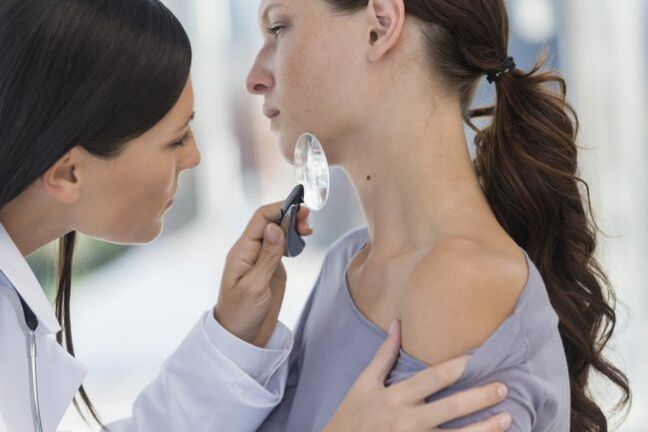
This disease accompanies humanity for a hundred years and probably from the moment of its appearance.Researchers find the remains of mummified ancient people who were patients with psoriasis.During the Middle Ages, this disease was often confused with leprosy and only in the mid -19th century.Psoriasis is defined as a separate disease - from that moment the scientific study of the disease has begun.Surprisingly, to this day, scientists cannot fully understand the cause of the disease.There were several theories on this occasion:
- Heredity.The cause of the disease is the breakdown in the immune system, hereditary.So, if one of the parents is ill with psoriasis, the likelihood of a child's illness is about 20%.If both parents have a disease, the likelihood of psoriasis in a child increases to 80%.Scientists note that not the disease itself is inherited, but only a predisposition to its occurrence.
- Viral theory.The justification that the causative agent of psoriasis can be a virus has tried to find many scientists.No confirmation of this theory has been found at the moment.However, other infectious diseases - influenza, tonsillitis, acute respiratory viral infections can affect the course of the disease, causing exacerbation or becoming a trigger for the first external manifestations of psoriasis.
- Immune theory.The most justified and universally recognized version of the appearance of psoriasis.The bottom line is that the cause of the disease is a disorder in the cellular bond of immunity.More and more scientists are inclined to the fact that the disease is autoimmune - that is, the body's defenses turn against themselves and begin to reject skin cells, perceiving them as aliens.
- Exchange theory.To find the causes of the pathology, scientists have conducted numerous examinations of patients with psoriasis.During this process it was found that they all had metabolism disorders.More special, low body temperature;elevated blood cholesterol;Disturbed balance of vitamins.All this leads to the conclusion that disorders in the exchange process play an important role in the onset of the disease.
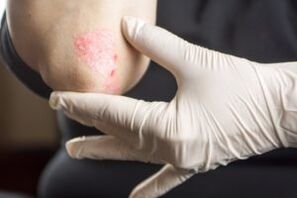
Factors provoking the development of psoriasis
The fact that there are some triggers that cause the disease or provocative exacerbation is known by both the patients themselves and the treatment of doctors.Such reasons include:
- Stress, nervous surge, psychological trauma;
- Hormonal disorders;
- Taking certain medicines: antibiotics, B vitamins, anti -inflammatory drugs;
- Mechanical skin injuries: cuts, burns, deep scratches;
- Infectious diseases: tonsillitis, otitis, sinusitis, as well as infections caused by streptococcus - alena fever, erysipelas, etc.;
- Drinking alcohol, mismatch with regime, malnutrition, smoking;
- Cut climate change, long -term sunshine.
Symptoms of psoriasis
How to recognize signs of insidious disease and prevent it from spreading?The course of psoriasis is cyclic: exacerbation periods are replaced by periods of remission.The disease has several forms, each has its own distinctive features, but there are common symptoms whose totality clearly indicates the presence of psoriasis in the patient.This is so -the named psoriatic triad:
- The phenomenon of the stearin drop.If you spread the surface of the psoriatic plaque with the nail, keratinized skin flakes, similar to the drops of frozen Starin, will be separated from it.
- Under the separated layer of keratinized particles a red shiny thin film is found.
- "Bloody dew."If you are scrapping this movie with the nail, small drops of blood will be filled.The fact is that there are thin -wall capillaries under it, and many points have a lot of physical effect.
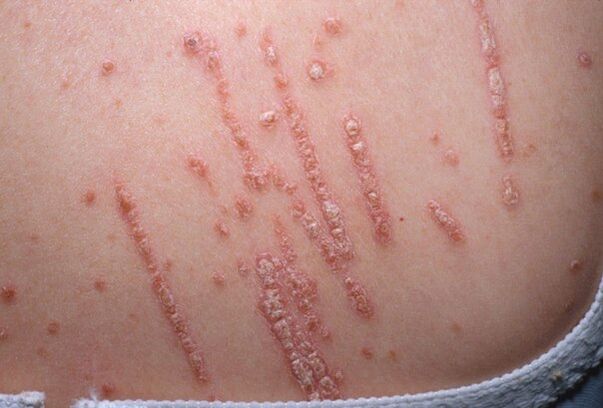
All these symptoms are accompanied by itching in the affected area.Most often, the first psoriatic plaques appear in places such as knees, elbows, inguinal region, scalp, armpits.First, the rashes are single, but with the development of the disease, their number increases and plaques can merge with each other, affecting the growing surface of the body.Kebner syndrome also emerges - the appearance of new rashes in skin irritation sites.
Vulgar or ordinary psoriasis
One of the most common forms of the disease is 80% of patients with psoriasis is diagnosed precisely by psoriasis vulgaris.The most characteristic feature is the appearance of the body of the reddish papules - nodes that have a rounded shape, clearly defined boundaries and slightly rise above the skin.The spots are covered with a greyish raid from the separated flakes.The rash can affect both the individual parts of the body and spread throughout the skin, located mainly in the folds of the skin, joints of the joints, places with frequent contact and rubbing the skin on the clothes.
Scalp psoriasis
In this form of the disease, mainly part of the head covered with hair, but with a more increasing course of the disease, the plaques can spread to the face, ears and neck area.Because it is quite difficult to see what happens on the head independently, often at the initial stage of psoriasis of the hair, they confuse with ordinary dandruff and do not attach much importance to the symptoms.What are the signs of you to warn:
- Dry scalp;
- Severe itching;
- Pain and burning in the affected area;
- The appearance of peeling, similar to dandruff;
- Hair loss.
Nail psoriasis
Psoriatic onychestrophy or nail psoriasis can manifest as an independent disease and is a complication of ordinary psoriasis.The external signs of the disease are very similar to a fungal infection.The nail plate thickens, its color changes - it can range from yellowish to gray.Naked eyes are visible traces of underwater hemorrhages - spots of red or purple.There is an oil stain syndrome - a yellowish spot under the nails.The nail itself is flattened, it becomes rough to the touch, there are pressed traces in the center.Small holes also appear - like needle injections, the surface begins to look like a thimble.Under the nails of the nails begins the process of accumulating dead cells, in the future this can lead to the detachment of the nail and its loss.Both nails on the fingers of both hands or only a few can be affected.
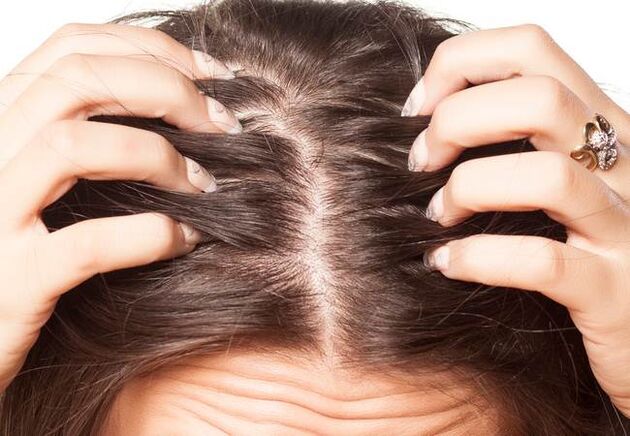
Pustulenia Psoriasis
It differs from the usual in that the lesion is characterized by the appearance of redness and pustules - bubbles with purulent content.With the more increasing development of the disease, the bubbles begin to peel off, exposing the surface of erosion.Pustular psoriasis has a more severe course, can be complicated by the relationship of secondary infection, intoxication of the body to death.
Genital psoriasis
Quite a rare form of disease.It is characterized by the appearance of small falling plates up to 1 centimeter in diameter.Favorite places: limbs and body.The appearance of rashes is accompanied by severe itching, often preceded by the transferred streptococcal infection.
Psoriasis supported by Ladomary
It is diagnosed in 15% of all patients with psoriasis.This shape is characterized by the appearance of papules on the palms and soles of the legs.In the affected areas there is severe itching and heat, often the skin cracks and bleeds.Patients experience severe walking difficulties, inability to perform any actions with their hands.The pustular type of palmar psoriasis is characterized by the appearance of redness and bubbles with a liquid content of the skin.
Exudation psoriasis
This type of disease is characterized by the formation of weeping plaques with uneven edges, covered with multiple layers of gray bark.Such crusts are formed by impregnation of keratinized particles by exudate when they try to remove them, the plaque becomes a reddish color, it can begin to bleed.This form is often found in patients in the history of which there are problems in the functioning of the endocrine system, metabolic disorders, diabetes mellitus.
Psoriatic arthritis
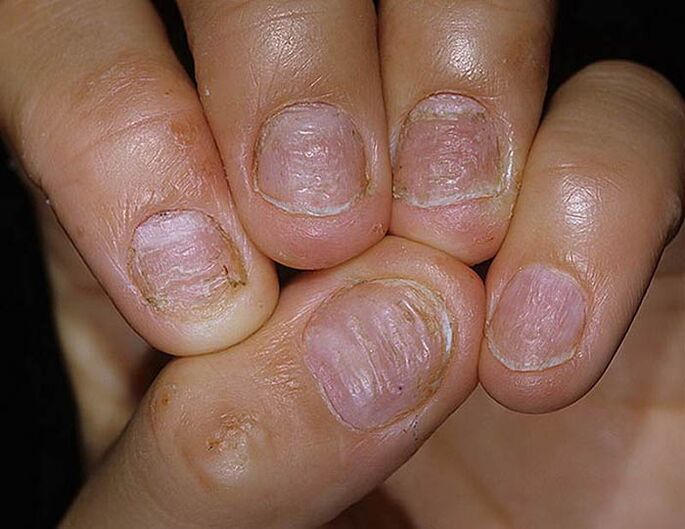
It is characterized by a set of symptoms of psoriasis and arthritis.Patients experience joint pain, limited in their mobility, the fingers swell severely, the skin around them acquires a bluish tint.In addition, the disease can affect the spine and sacrum.In addition to the joints, tendons and cartilage of the joints, they also suffer.
Diagnosis of psoriasis
As with the treatment of any other disease, the main thing is to understand the enemy from a person and to initiate complete treatment as soon as possible.The first thing you need to do if you suspect that the presence of psoriasis is to contact a dermatologist.The doctor will conduct a visual examination, make a scraping from the affected area and prescribe the tests:
- General blood test;
- General urine analysis;
- Kale Analysis for goalist eggs.
- Blood test
- Urine analysis
- Kale analysis
Sometimes these measures may not be sufficient for an accurate diagnosis, as the symptoms of psoriasis can be expressed crushed.In this case, in order to distinguish psoriasis from other similar skin diseases, a biopsy is prescribed - separation of a piece of tissue and subsequent histological examination in the laboratory.In addition, the doctor collects information about clinical manifestations, patient complaints, as well as the image of his life, the presence of bad habits and a hereditary predisposition to the disease.
Psoriasis
Unfortunately, it is impossible to completely get rid of psoriasis.However, this does not mean that you simply cannot pay attention to the presence of this diagnosis.Subject to all the recommendations prescribed by your doctor, you can achieve a constant long remission and live for years without remembering that you are ill with psoriasis.There is no universal methodology of treatment as it depends on factors such as:
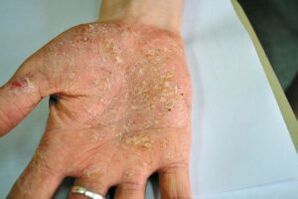
- Patient age;
- Type of psoriasis;
- The size of the affected areas and the location of their location;
- The severity of the disease.
As a rule, the treatment of psoriasis is a set of measures aimed at eliminating and mitigating the symptoms of the disease, maintaining the body's strength, eliminating the cause that causes exacerbation of the disease.
Drug therapy
The rest of the disease will have to fight the disease, so the following treatment technique has been developed for patients with a diagnosis of psoriasis: first, sparing medicines with the smallest side effects are prescribed.If therapy has no proper effect, the drugs are replaced with helpful.But even a course of medication will need to change from time to time.This is necessary so that the body is not used for a particular medicine and the effect of its action goes to nothing.Treatment involves taking medicines and local ointments.The following medicines are prescribed:
- Antihistamines - itching relief, give rise to sleep at night;
- Retinoids - vitamin A derivatives - have a beneficial effect on the skin condition;
- Enterosorbents - their purpose is to cleanse the body of toxins;
- Hepatoprotectors - have a protective and restorative effect on liver cells;
- Enzymes-the help of the gastrointestinal tract handles the load;
- Non -steroidal drugs - relieve inflammation and pain;
- Antibiotics - are necessary in cases where the course of the disease is complicated by the relationship of the infection;
- Cytostatics - reduction of pathological increased increased cell division;
- Immunosuppressants;
- Organic products.

In the initial stage of psoriasis, unpleasant symptoms can eliminate various ointments and creams, which are also a mandatory component of a complex of measures in the treatment of advanced cases of the disease.These agents can be divided into two large groups: non -hormonal and hormone containing.
Physiotherapy
- A few decades ago, the positive effect of UV rays on the skin affected by psoriasis was proven.Today, this method has been used successfully in the treatment of the disease.O Radiation is carried out with the help of special installations and can be exposed to the whole body and only separate areas.
- Patients diagnosed with psoriasis often begin to suffer from depressive disorders associated with disease experiences.In this case, the electron can help.The procedure has a sedative effect, the patient relaxes, his psychological condition is stabilized.All this favorably affects the course of the disease.
- Magnetotherapy helps to improve blood circulation, reduce itching, normalize metabolism.
- The procedure of cryotherapy or cold treatment has also proven its effectiveness in the treatment of psoriasis.The affected areas are exposed to liquid nitrogen money, as a result, itching is reduced to reduce the active metabolic processes in the skin cells.
- Treatment with a resort sanatorium can have a very beneficial effect and encourage the patient to come up at the remission stage.
If you have diagnosed psoriasis, try not to despair.Medicine does not stand still and more and more advanced medicines appear every year, which allow you to get rid of the symptoms of the disease for a long time.Follow all your doctor's recommendations, lead a healthy lifestyle and, as far as possible, avoid factors that can cause exacerbation.























